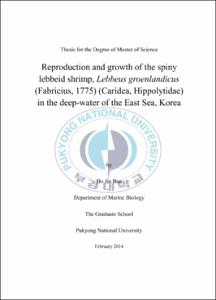Reproduction and growth of the spiny lebbeid shrimp, Lebbeus groenlandicus (Fabricius, 1775) (Caridea, Hippolytidae) in the deep-water of the East Sea, Korea
- Abstract
- Reproduction and growth of the spiny lebbeid shrimp, Lebbeus groenlandicus (Fabricius, 1775) are investigated in the East Sea of Korea from January 2012 to April 2013. An understanding of the reproductive strategies of a species is critical for understanding its population dynamics and biogeographic patterns (Ramírez-Llodra, 2002). Deep sea species would not undergo the seasonal periodicities in breeding shown by their relatives in shallower water subject to annual change in water temperature, but, instead, breeding would take place year-round (Orton, 1920). Population parameters are necessary in order to understand the health of any fishery to determine appropriate management measures (Nwosu, 2008). The proportion of females was significantly greater than that of males (male:female ratio, 4.6:5.4). Females were predominant on larger class size than males. Significant differences on slopes of carapace length versus body weight linear regression between sexes indicate sex-specific differences in allometric growth. The gonadosomatic index (GSI) varied monthly, reaching a maximum in November 2012 (10.28) and a minimum in March 2013 (2.15). Monthly variations in the proportions of ovigerous females showed all months. The highest values of the GSI coincided with the breeding period of L. groenlandicus. There was significant difference between the mean GSI of females with non-eyed and eyed eggs, indicating that L. groenlandicus is a consecutive breeder. There was a significant correlation between carapace length and the number of eggs at early egg stages. There was significant difference in the slope of the regressions of carapace length versus the number of eggs between females carrying non-eyed and eyed egg stages, indicating that there was brood loss during the incubation period. Based on dry weights in early egg stages, reproductive output was determined 0.18±0.006. The von Bertalanffy growth function parameters were 〖CL〗_∞=38.80 mm,K=0.48 〖yr〗^(-1),C=0.5,WP=0.4 for males and 〖CL〗_∞=43.64 mm,K=0.41 〖yr〗^(-1),C=0.6,WP=0.6for females. The growth performance index (φ') is 2.86 for males and 2.89 for females. This study verified the biological characteristics of L. groenlandicus inhabiting the deep sea in the East Sea of Korea. The present study will help manage fisheries resources based on ecological parameters, which was provided from the study.
- Issued Date
- 2014
- Awarded Date
- 2014. 2
- Type
- Dissertation
- Publisher
- 부경대학교
- Affiliation
- 대학원
- Department
- 대학원 해양생물학과
- Advisor
- 오철웅
- Table Of Contents
- CONTENTS
List of figures iv
List of tables vii
Abstract ix
1. Introduction 1
2. Material and methods 4
2-1. Sample collection 4
2-2. Sex ratio 4
2-3. Length-frequency distribution 6
2-4. Morphometric relationship 6
2-5. Ovarian examination 8
2-6. Egg size 10
2-7. Relationship between body size and the number of eggs 12
2-8. Fecundity and reproductive output (RO) 13
2-9. Size at sexual maturity (〖CL〗_50 ) 14
2-10. Growth 15
2-11. Statistical analysis 17
3. Results 18
3-1. Sex ratio 18
3-2. Length-frequency distribution (LFD) 18
3-3. Morphometric relationship 21
3-4. Breeding period 26
3-5. Fecundity and reproductive output 29
3-6. Size at sexual maturity (〖CL〗_50) 35
3-7. Growth 37
4. Discussion 41
4-1. Sex ratio 41
4-2. Length-frequency distribution (LFD) 42
4-3. Morphometric relationship 43
4-4. Breeding period 44
4-5. Fecundity 46
4-6. Reproductive output 49
4-7. Size at sexual maturity 51
4-8. Growth 52
5. Acknowledgement 58
6. References 61
- Degree
- Master
- Files in This Item:
-
-
Download
 Reproduction and growth of the spiny lebbeid shrimp, Lebbeus groenlandicus (Fabricius, 1775) (Caride.pdf
기타 데이터 / 2.81 MB / Adobe PDF
Reproduction and growth of the spiny lebbeid shrimp, Lebbeus groenlandicus (Fabricius, 1775) (Caride.pdf
기타 데이터 / 2.81 MB / Adobe PDF
-
Items in Repository are protected by copyright, with all rights reserved, unless otherwise indicated.